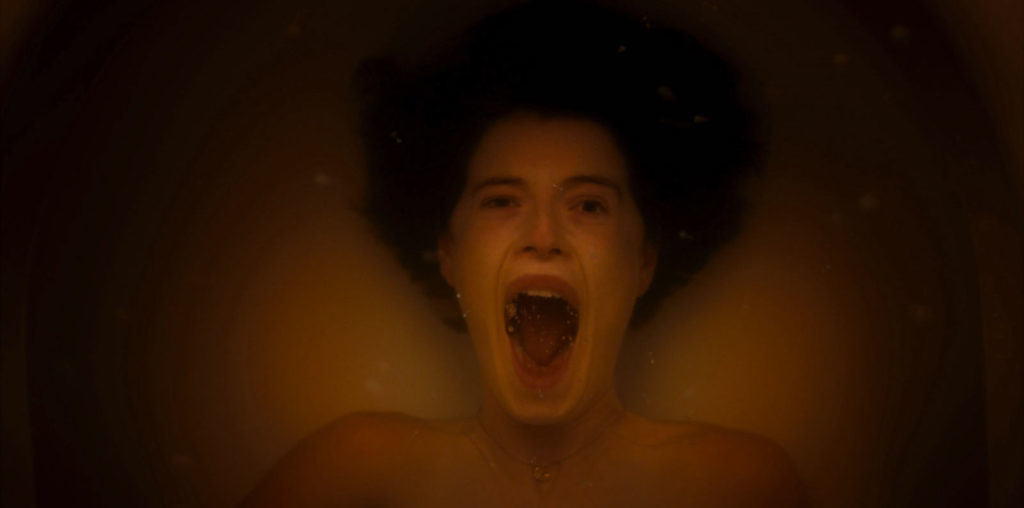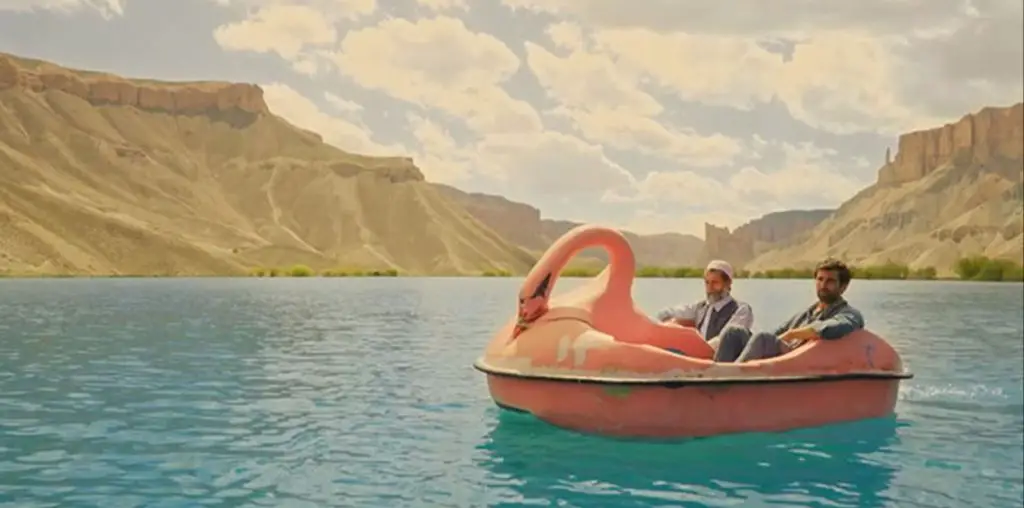
Unless you are a rabid devotee of independent cinema, there is a good chance that you are unfamiliar with Antero Alli. The Finnish-born, Berkeley-based artist concentrates on the creation of lower-budget videofilms which have primarily been seen in alternative venues on the U.S. West Coast. While this obviously denies Alli the access to a wide national audience, it has brought him a devoted cult following among aficionados of fringe cinema.
Alli’s films are not for the easily distracted. His films are challenging and sometimes cryptic in their dissection of human emotions and societal interactions; repeated viewings, however, reveal layers of wisdom and wit that may not have been obvious in the initial screening. His documentary “Archaic Community” (1992) details a sociological/theatrical experiment in which a group of strangers are brought together via a series of exercises which trace the genesis of ritualistic behaviors. His feature “The Drivetime” (1995) offers a sci-fi tale of a time-traveling librarian seeking to retrieve lost video footage, but the film is infused with undercurrents which focus on how a society obsessed with telecommunications technology is losing the ability to deal in a person-to-person manner. The short subjects “Requiem for a Friend” (1991) and “Lily in Limbo” (1996) focus on the pain of loss–the former visualizing Rilke’s elegy to one who is dearly departed, the latter on a bitter artist who isolates herself from the world until she can no longer differentiate reality from fantasy.
Beyond his own work, Alli also curates and produces (along with his reel-life and real-life partner, actress/composer Sylvie Pickering) the Nomad VideoFilm Festival, a traveling presentation of original shot-on-video productions from independent filmmakers. Alli is also a prolific author and playwright; his latest production, the multimedia stage production “Hungry Ghosts of Albion,” enjoyed a successful run in San Francisco earlier this year. And for the first time, Alli will enjoy a wide home video release when “The Drivetime” debuts next year via the new Cutting Edge Cinema label from Sub Rosa Studios (www.b-movie.com).
Film Threat caught up with Alli, who recently finished post-production on his latest film, an intriguing documentary on crucifixion rituals entitled “Crux.” He discussed his work as an independent filmmaker, focusing on his inspirations in the creation of his productions and reactions to critics and audiences.
[ It’s easy to list the obvious advantages and disadvantages of being an independent filmmaker–the joy of self-expression, the scramble to raise funds, etc. But what are the less-than-obvious advantages and disadvantages that you’ve encountered in your work…issues and concerns that you may not have considered before pursuing filmmaking? ]
Since I favor an impartial use of multiple mediums (film, video, animation, etc), I view myself more as a mediamaker than a filmmaker, per se. In my case, it’s a relevant distinction, as well as, a nod of respect to those working exclusively in film. The advantages to making my own media are both simple and severe. I either do it or die, or worse yet: numb down in that dismal, dreary, consumer sort of way. Sometimes I feel driven by a vengeance for forcing visions upon the world; visions and impressions that have been assaulting my sensibilities for a long time.
Mediamaking suits this obsession very well and I think that’s got to be the main advantage for me. The chief disadvantage, which may be a dare in disguise, is succumbing to any economic and cultural pressure to compromise your work (and how it’s publicized) by conforming to externally defined values, categories and genres. This clearly sucks. If you’ve been lucky enough to make this mistake in a way that really hurt you and if you are smart enough not to repeat the error, you can turn this disadvantage to your favor. The greater the disillusionment, the greater the clarity afterwards…the way of the world…
[ Your films deal with some very troubling subjects–alienation, the breakdown in interpersonal communications, people pushed to emotional extremes. Yet your films are never heavy nor depressing. How do you address these mature subjects without getting weighed down in Bergman-style doom and gloom? ]
Probably because I’m not nearly that good yet. Bergman’s a genius and he referred to Andrei Tarkovsky, one of my favorite filmmakers, as a kind of teacher; if you’ve seen his work, you’ll know why. The pacing, the texture, the editing and the real time captured in each frame of Tarkovsky’s films breathes with so much exquisite gloom it almost brings dying back into style. I die every time I see his epic, “Andrey Rublyov” or his last film, “The Sacrifice.” A kind of ego-death, if you will, that allows for a more fluid passage of real time, the time of my life, to unfold. My own personal style tends more towards the glib and the arch, no matter what the subject matter.
I treat my themes as truthfully as I can. And as I see it, the truth is serious enough as it is; why leaden it any more? This is a complex question due to what I believe to be the subjective nature of truth. What is worth filming or creating a movie about? What is worth saying that has not been said before in a more effective way? It’s a humbling process, coming to terms with what and how to write, shoot, direct and edit but that’s how it should be. Otherwise, it may not be worth watching.
[ You’ve made documentaries and dramas, features and shorts. Which genre do you prefer to work in…or do you prefer not being restricted to a single genre? ]
This usually depends on what I need to learn next. For example, I might approach a documentary after completing a project that was, for me, a deeply creative and personal vision. There’s this need to utterly immerse myself in my own world, as much as there’s an equal need compelling me to be free of that world. Some projects are more identity-defined, while others are more devotional to something other than myself. I go for that long-term kind of balance. I also choose projects based entirely on who I get to work with. I’ve also been known to sign up six months of my life for a new technical challenge, such as an opportunity to edit on equipment I’ve never used before.
[ You’ve created films based on the works of Neruda, Rilke, Plath–not really the traditional source of cinematic adaptations. What draws you to filming literary works which most filmmakers would not consider? ]
Besides being a lover of great poetry, it’s easy for me to think of cinema in poetic terms. I’m intrigued by the use of poetic text as oblique narrative. In my first feature, “The Oracle,” a grandfather character is on his deathbed and talking in his sleep. His daughter and the nurse sit there dumbfounded, as his words form these poetically precise questions (from Pablo Neruda’s “Book of Questions”); cut to a bardo-like afterlife scene where his nine year-old granddaughter guides him through the dark woods. With Rilke’s “Requiem for a Friend,” the challenge was to narrate the epic lament as a story, not a poem. To keep it cinematic and theatrical, it’s important to break down conventional ideas about poetry and how poems should be read and find instead, the story in the poem.
[ Your films are primarily seen by audiences in alternative venues which specialize in smaller films, especially those shot on video. But when you consider the economics of film exhibition, do you believe these alternative venues and their eclectic fare can ultimately compete (from an economic, not an artistic standpoint) against the multiplexes? ]
I don’t think there is any real competition between these levels, especially if we’re talking about work that aspires towards commerciality and respectability in that consensus mainstream Hollywood sort of way versus work with little or no commercial value whatsoever. Since my own work leans heavily towards the latter, I don’t feel the heat of competition as much as the appreciation from those who seek out alternative media and the fringe-dweller values that define it. Besides, I dig the view from the outer limits, the margins…
[ What was the genesis of the Nomad VideoFilm Festival? And why a traveling festival versus a single venue? ]
Around the time Nirvana put Seattle back on the alternative map (1992), Nomad started up as a bimonthly nomadic screening room for experimental media. For the next two years we set up our big screen video monitor and sound system, every other month, at a different Seattle venue; night clubs, restaurants, art galleries, warehouses. And then, we burnt out. A year later, in 1995, I reorganized it as the Nomad VideoFilm Festival, an annual pacific coast touring venue. I did this for two reasons. First, it gave me a good reason to take a paid travel vacation and turn people on to subversive media. Secondly, because the tour visits small towns and big cities, it offers a variety of audience feedback (Port Townsend, Seattle, Portland, SF, Mendocino, Berkeley and others). We ask the audiences in each town to write down their reactions to the work and then, we send this feedback straight to the mediamakers.
[ All filmmakers encounter negative criticism, and you have not been immune to critical rebuke. “The Drivetime” was recently dismissed by the Amazing World of Cult Movies (URL: www.awcm.com) as a “silly mess” and you were equated with being “a ninny.” How do you react to harsh criticism, from both an artistic and an emotional standpoint? ]
Though I often remind myself that any review is only one person’s opinion, harsh reviews always hurt. What are you going to do? Stop reading all your reviews? That’s just more self-stabbing victim bullshit. Why not pick up some objectivity and identify the bias of the reviewer just to see where they are coming from? Just for fun. When I do this, it’s understandable why The Amazing World of Cult Movies calls me a “ninny” and my movie a “silly mess”. That’s very funny. If I were as cynical and jaded as them, I’d probably say the same thing.
To confound things, “The Drivetime” was also given glowing reviews by Wired Magazine, the Pacific Film Archive and the NW Film Forum and these guys didn’t even call me names. Of course, their bias and outlook are, for the better part, already more aligned with my own. And I like that. If they had trashed my movie, I’d probably feel more hurt than the cynic who called me a ninny.
For me, the best reviews are instructive and these are very, very rare. Most film critics have seen too many movies and suffer imagination loss, in addition to having weakened their critical judgement for constructive praise. That’s a mouthful. The worst reviews must be the most indifferent reviews and, knock on wood, I’ve not seen one for my work yet.
[ Critics can elevate a smaller film to unexpected success (i.e., “The Full Monty” and “The Blair Witch Project”), but they can also eviscerate a film into financial failure. As a filmmaker, how do you view the power of the critics? ]
Of course, critics can make or break a show in terms of sheer audience attendance; that’s their godawful power and responsibility. As for myself, I usually go see those films that have elicited at least two opposing reactions from different newspapers. Why? The best work always confounds genres. It outgrows previous genres while mutating its own.
Unless critics are still capable of creative thought, they will tend to pan a movie they cannot pigeonhole and, often enough, to justify their own pet dogmas. In my own mind, critics only have the power I give them and from my ranting, you know that’s not very much. In the real world, however, critics are media gods blessing and cursing the fates of filmmakers everywhere.
[ Tell us about “Crux”–what it is about, how it came about, how it fits into your body of work? ]
“Crux” is an 80-minute documentary video of an esoteric group of northern
California ritualists exploring the crucifixion archetype. Not through Jesus or Christianity but through addressing crux-like questions like “What am I living for ?” and “Where and how am I crucified?” It’s a very low key approach to deep drama; a kind of spiritual journey story of eight individuals committed to exposing the crux of their lives to themselves, to each other, to the camera. The story revolves around the thoughts and reactions of these individuals to something called the Submerged Cross Ritual. This ritual was designed by myself (based on work from one of my many books, “All Rites Reversed: Ritual Technology for Source Relations”). You see, I’m also a ritualist.
I don’t know yet how “Crux” fits into the rest of my work; maybe it doesn’t. It does treat a somewhat somber and mystical theme in a somewhat glib way; it’s both reverent and irreverent. Maybe it’s reverent enough to be irreverent, I don’t know. I’ve just finished editing it and I’m so close to it, I’m jonsing for audience response. It’d be nice to pick up a little objectivity.
[ What advice would you give to aspiring filmmakers and aspiring film critics? ]
I have no advice at all for aspiring filmmakers but heartfelt discouragement. If you cannot or will not throw yourself into this crazy-making process with all your will, heart, guts, mind, soul and money, then you will never know what it means to realize your dreams in this medium. This medium does not treat half-baked attempts kindly. Most movies demonstrate this in living Technicolor. Here’s a warning for you: I go a little more crazy with each and every project but it is going crazy in the name of creation, not destruction. And that kind of crazy I can live with and, live for.
As for critics, there may be no hope unless you find ways to teach us as you criticize. You may be able to do this if you commit to learn new ways to keep learning. Know your bias. It always shows, anyway, and you suffer less when you are not the last to know.
Antero Alli can be visited on the web at www.paratheatrical.com
Check out FILMTHREAT.com’s INTERVIEW ARCHIVES and read hundreds of fascinating in-depth interviews with directors, filmmakers, actors and celebrities from the world of film!


